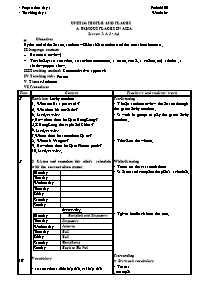Giáo án môn Tiếng Anh Lớp 7 - Unit 16: People and places - A. Famous places in Asia - Lesson 2: A3-A4

I. Objective:
By the end of the lesson, students will be able to understand the text about interests.
II. language content:
- Grammar: (review)
- Vocabulary: an attraction, an ancient monument, a resort, coral , a culture, (to) admire , a shadow puppet show.
III. Teaching method: Communicative approach
IV. Teaching aids: Posters
V. Time: 45 minutes
Bạn đang xem tài liệu "Giáo án môn Tiếng Anh Lớp 7 - Unit 16: People and places - A. Famous places in Asia - Lesson 2: A3-A4", để tải tài liệu gốc về máy bạn click vào nút DOWNLOAD ở trên
- Preparation day : Period:100 - Teaching day : Week: 34 UNIT 16: PEOPLE AND PLACES A. FAMOUS PLACES IN ASIA Lesson 2: A 3 - A4 Objective: By the end of the lesson, students will be able to understand the text about interests. II. language content: Grammar: (review) Vocabulary: an attraction, an ancient monument, a resort, coral , a culture, (to) admire , a shadow puppet show. III. Teaching method: Communicative approach IV. Teaching aids: Posters V. Time: 45 minutes VI. Procedure: Time Content Teacher’s and students’ work 5’ 5’ 10’ 15’ 10’ Revision: Lucky numbers 1. Who sent Ba a postcard ? 2. What does his uncle do? 3. Lucky number 4.How often does he fly to HongKong? 5.Is HongKong the capital of China? 6.Lucky number 7.Where does he sometimes fly to? 8. Where is Yangon? 9. How often does he fly to Phnom penh? 10.Lucky number. 3. Listen and complete this pilot’s schedule with the correct place names. Monday Tuesday Wednesday Thursday Friday Saturday Sunday Answer key Monday Bangkok and Singapore Tuesday Singapore Wednesday Jakarta Thursday Bali Friday Bali Saturday HongKong Sunday Back to Ha Noi Vocabulary - an attraction : ñieàu haáp daãn, caùi haáp daãn - an ancient monument : Töôïng ñaøi coå xöa - a resort : khu nghæ maùt - coral (unc): san hoâ - a culture : neàn vaên hoaù - (to) admire : chieâm ngöôõng - a shadow puppet show : maøn trình dieãn muùa roái. Pre-questions: Why do tourists like to visit South East Asia? Text, page 156 Answer key Because South East Asia has many atractions Questions: a)The passage mentions three kinds of tourist attractions. What are they ? b)What kinds of attractions do you prefer? Answer key a. The three kinds of tourist attractions mentioned in the passage are ancient monuments, shows and resorts. b. ( Students’ answer) Matching Three kinds of tourist attractions that go with the activities Three kinds of tourist attractions Activities 1. Ancient monuments a. You can swim and dive b. You may visit the Khmer temples of Angkor Wat. 2. Shows c. You can see colorful dances or shadow puppet shows. d. You may admire colorful corals and fish . 3. Resorts and beaches e. you can listen to and enjoy traditional music during the performances. f. You can sail and enjoy a healthy outdoor life. Answer key 1.b 2. c, e 3. a,d,f Transformation writing Change the text from “South East Asia” to “Viet Nam”, “ Khmer temples of Angkor Wat” to “ Hue” Ancient City” , “ the huge Buddist temples of Borobudur in Java” to “ Hoi An ancient street” ( in paragraph 1) . Homework - Learn new words and read the text again. - Prepare Unit 16 : B1,B3 Pre-listening - T helps students review the lesson through the game lucky numbers. - Ss work in groups to play the game lucky numbers. - T declares the winner. While-listening - T turns on the cassette 3 times - Ss listen and complete the pilot’s schedule. - T gives feedback from the text. Pre-reading + Pre-teach vocabulary - T uses: . example . translation . example . picture . example . traslation . translation - Ss listen repeat and copy - T checks: ROR + Pre-reading activity i - T sets the scene: “ You are going to read the text about the interests in South-east Asia.” - Ss listen to the situation. - T gives students the pre-question. - Ss guess the answer for the question and say their guesses. - T writes their guesses on the board. While-reading - T asks students to read the text and check their guesses. - Ss work in pairs to read the text and check their guesses, and then give the answers. - T gives feedback. - T asks students to read the text again and answer the questions. - Ss work in pairs to read the text and answer the questions, and then write the answers on the board. - T gives feedback. - T asks students to read the text again and do the matching exercise. - Ss work in pairs to read the text and do the matching exercise , and then give the answers. - T gives feedback. Post-reading - T asks students to write the passage by changing the information. - Ss work in groups to write the passage. - T checks their result. Remarks:
Tài liệu đính kèm:
 giao_an_mon_tieng_anh_lop_7_unit_16_people_and_places_a_famo.doc
giao_an_mon_tieng_anh_lop_7_unit_16_people_and_places_a_famo.doc





